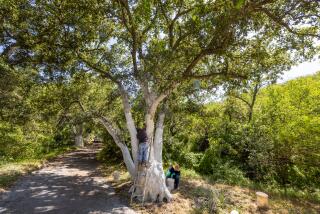Tiny Pest Clouds Future of Smoky Mountains’ Firs
- Share via
CLINGMANS DOME, Tenn. — The clouds part atop the Great Smoky Mountains’ highest peak to reveal an eerie summit of denuded gray spires.
Skeletons of old Fraser firs stand like sentinels over an ancient 6,643-foot-high vista of blue-green North Carolina and Tennessee mountains.
“What happened to the trees?” asks Howard Dover, a visitor from Troy, Mich. “Was there a fire?”
Fire didn’t kill these trees. Neither did air pollution or acid rain, though they may play a role. A tiny bug called the balsam woolly adelgid has been slowly laying waste to the spruce-fir forests of Southern Appalachia for decades. It’s estimated that 70% of the Smokies’ firs are gone--all in the last 30 years.
Since 1982, park managers each summer sprayed soapsuds from fire hoses on the most accessible firs on Clingmans Dome, drying out the aphidlike adelgids like salt on a snail. But the effect was temporary, and the spraying ended last year.
“We felt that it was maybe time to let nature take its course,” said Smokies resource specialist Kristine Johnson.
But the Smokies, the country’s most visited national park, are a vast, half-million-acre preserve. And within its expanse may be hope yet for the firs.
Some eight years ago on a pleasure hike to remote Mt. Guyot, Johnson made a discovery: She found old Fraser firs, alive and healthy.
“They looked like fir trees used to look. It was strange,” she said. “I looked over that stand at the top of Guyot, and I just got to wondering how many more there were.”
Entomology professor Fred Hain from North Carolina State University is now trying to find out in a study underwritten by the Friends of the Smokies and retailer Home Depot, which sells Fraser firs as Christmas trees.
“We want to look at these remnant trees and determine conclusively that there are some that are resistant to the balsam woolly adelgid,” Hain said as he led a graduate-level class on an adelgid hunt atop Balsam Mountain in early August.
“We know other fir species do have resistance. If we find at least a portion of the Fraser fir population has this resistance as well, then that opens up all kinds of avenues for us,” he said.
Though adelgids were thought to attack only mature trees, Christmas tree farmers in North Carolina are now finding them in their fir groves--turning pointy-topped yuletide treasures into flat-topped bushes. This is no small concern for the state’s $100-million Christmas tree industry, second only to Oregon’s.
“Maybe we can come up with a resistant tree for the Christmas tree industry, or maybe we can even do some restoration projects in natural areas,” Hain said.
But a lot of work remains to be done in the forest and the lab.
The balsam woolly adelgid is native to the forests of Europe, where the trees’ thicker bark can fight off an attack that looks like a fine whitewash of small cotton clumps.
The insects arrived in the United States in the early 1900s and were first spotted in the Smokies in 1963, presumably carried by birds, the wind and backpackers.
Hain thinks the surviving firs in the Smokies may have developed thicker bark too. An extra one-tenth of an inch in thickness is enough to prevent a kind of allergic reaction to the bugs that eventually suffocates the tree. Attacked trees don’t die immediately; they can linger two to seven years.
Hain also has another theory. He has found that firs produce a substance called juvabione that is similar to a growth hormone in the adelgids. Enough juvabione, and the bugs fail to fully mature and don’t produce as many eggs. The theory seems to pan out in the lab, but field testing is needed, he said.
The researchers will be concentrating on about a half-dozen acre-size mountaintop plots where Johnson has found surviving firs.
“That is where the hope lies,” Hain said. “If there are a few trees for whatever reason--luck, probably--that have some resistance, then we can exploit that.”
Looking out from Clingmans Dome, Dover pauses for a moment.
“I hope they figure it out quickly, because there is a lot to lose.”
More to Read
Sign up for Essential California
The most important California stories and recommendations in your inbox every morning.
You may occasionally receive promotional content from the Los Angeles Times.













